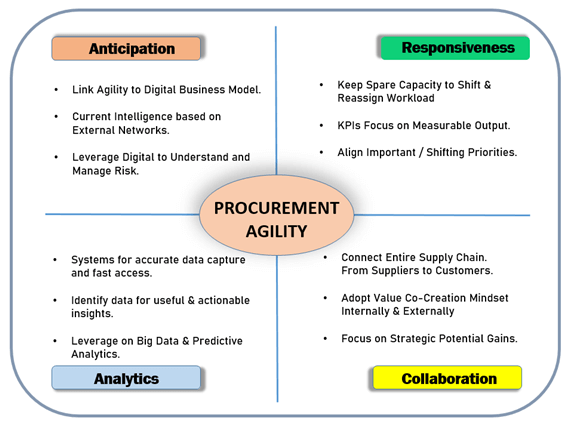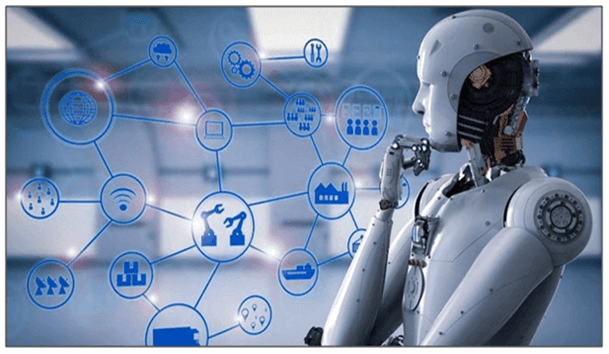Artificial Intelligence (AI) and Procurement Agility are the current big buzzwords in the procurement domain. COVID-19 has affected business operations in unpredictable markets and supply chains. Procurement professionals must enable greater agility and resiliency to handle this market volatility and uncertainty.
It is thus important to define how AI contributes to allowing the procurement function to be nimble and agile. Firstly agility is simply having the ability able to think and move quickly and easily. To achieve agility, procurement organizations need to have the knowledge and ability and this is where AI comes into the picture. AI uses smart computer algorithms to allow procurement departments to tackle work process complexity more efficiently and effectively leading to speed and flexibility which is procurement agility.
Table of Contents
The AI Fit in Agile Procurement
The four pillars of procurement agility are Anticipation, Analytics, Responsiveness, and Collaboration.

In the anticipation pillar, intelligence and network is made possible when digital procurement systems are tied to the external environment for constant updates. In the analytics pillar, AI analyses data to provide useful, actionable, and predictive insights to allow procurement decisions to be quicker and more impactful. AI facilitates the responsiveness pillar by automation of mundane procurement tasks and also sieving out useful data quicker thereby freeing up capacity for more strategic tasks. The collaboration pillar looks at how AI links the whole supply chain from suppliers to customers to allow for advanced demand planning.
AI-Enabled Procurement Agility
The innovation of AI technologies is required for redesigning and developing the whole supply chain to keep up with the constantly changing marketplace. Procurement agility is achieved through digital transformation, whereby a virtual and paperless fully networked environment is embraced, leveraging on powerful cloud infrastructure for data-fuelled market intelligence, and predictive analytics. Freeing up time and resources to focus on value add activities to tackle strategic procurement needs.

In a nutshell, AI enables Procurement in the areas of:
- Speedier Decision Making: Real-time analysis coupled with data-driven insights resulting in faster, better procurement decisions
- Discover New Opportunities: New savings and revenue opportunities are discovered through spending patterns derived from analysing the swaths of data available
- Efficient Operations: Improved by streamlining and alignment of various business operations no matter the organization size, number of business units, procurement categories, and geographic locations
- More Time: Time is freed up as AI automates routine time-consuming tasks such as purchase orders, various monthly processes, and performance reports. The time and labour can be diverted to focus on strategic and time-sensitive tasks.
- New Knowledge: AI captures relevant external data to be integrated with internal data for analysis, thereby providing new insights such as identifying new suppliers or even new markets to penetrate.
- Effective Supplier Relationships: AI provides data insights to further optimise supplier negotiations.
Agile Procurement Technologies
Technology drives faster, strategic, and smarter moves whereby procurement teams can implement both offensive and defensive strategies. For example on the offensive, good supplier relations can be built with the time freed whilst on the defensive, potential disruptions can be anticipated, allowing procurement teams to shift sourcing plans quickly when needed. The first step of digitization will increase procurement process velocity and the following technologies will transform the velocity into agility that procurement needs.
Machine Learning (ML)
ML is an automated self-learning statistical technology eliminating human errors from processes. Solving specific challenges leading to fast, efficient operations is a stepping stone on the pathway to agility. An example of Machine Learning is Predictive analytics for in-transit goods to address potential delays or problems of materials and products in transit before they happen.

The various types of Machine Learning are:
- Supervised Learning: Using past data to teach patterns, and automatically detecting them in new data. Humans supervise by providing correct answers for the algorithm to derive patterns in data. Spend classification is a common example of supervised learning in procurement.
- Unsupervised Learning: Not teaching the algorithm what to look out for. Used to derive logical, new, and interesting patterns in raw, new data.
- Semi-Supervised Machine Learning: Providing sufficient known data to allow the algorithm to learn by itself and produce new results.
- Reinforcement Learning: Mostly theoretical, the algorithm decides action in various situations, and behavior is rewarded or punished depending on the consequences.
- Deep Learning: An emerging opportunity in procurement whereby an advanced type of machine learning using artificial neural networks is utilized to progressively improve the ability to perform a task.
Natural Language Processing (NLP)
NLP is an AI capability that reads, understands, interprets and manipulates the human language. NLP learns from past data can uncover insights from existing data or enable new ways to streamline time-consuming processes. NLP enables procurement agility by reviewing text-heavy contracts and agreements to speed up basic processes and also flag out anomalies and suspect clauses. The ways NLP assists range from analysing wordings to find differences in contracts to detecting non-standard invoices and also detecting fraud on financial issues with suppliers. Thus expanding procurement’s cognitive ability without increasing headcount, while speeding up the fundamental processes.
Robotic Process Automation (RPA)
RPA is an AI tool that automates manual, repetitive, and standardized activities such as data entry. It is rigid and follows a set formula but it is as valuable as the other AI tools available. Leveraging on AI to achieve procurement agility, RPA is often the first tool to use. RPA reduces administrative work and the human error that comes with it thereby saving costs and time rendering accurate and efficient execution of procurement processes.
RPA is also not one dimensioned as RPA can act on the ML insights, for example sending notification alerts when nearing contract expiry, buying time for contract renegotiation. RPA can also automatically trigger one event from another. For example, if the ML algorithm discovers an anomaly in a contract, RPA will send the contract for further analysis by the legal department without us lifting a finger.

Big Data Analysis
This encompasses analysing large data packets spanning structured and unstructured data from internal and external sources. Internal data sources range from accounts transactions, enterprise resource planning, and suppliers data whilst external data sources cover data from social media, current market intelligence, and industry-specific information. Hidden patterns such as market trends and customer preferences can be discovered through Big Data.
The four categories of Big Data Analytics that facilitate Agile Procurement are:
- Descriptive Analytics: Analytics in its most basic form which makes data understandable by summarising findings.
- Diagnostic Analytics: To determine the why by drilling deeper into the data and understanding particular event root causes.
- Predictive Analytics: Forecasts event outcome probabilities by expanding on the preliminary descriptive analytics.
- Prescriptive Analytics: Prescribing future solutions by either proposing favourable outcomes following the specified course of action or suggesting courses of action to achieve a particular outcome.
The full content is only visible to SIPMM members
Already a member? Please Login to continue reading.
References
Andrew Chan YickLeng, SDDP. (2020). “Key Technologies for Agile Procurement”. Retrieved from SIPMM: https://publication.sipmm.edu.sg/key-technologies-agile-procurement/, accessed 16/04/2021.
Anushka Mehta, (2017). “Four Types of Business Analytics to Know”. Retrieved from https://www.analyticsinsight.net/four-types-of-business-analytics-to-know/, accessed 16/04/2021.
David Sweetman, (2018). “Five Ways Machine Learning Drives Competitive Advantage through Supply Chain Speed, Accuracy, and Agility”. Retrieved from https://www.digitalistmag.com/digital-supply-networks/2018/05/02/5-ways-machine-learning-drives-competitive-advantage-through-supply-chain-speed-accuracy-agility-06164041/, accessed 16/04/2021.
Giles Berault, (2018). “Procurement Agility in the Age of Digitalisation”. Retrieved from https://medium.com/swlh/procurement-agility-in-the-age-of-digitalisation-e5b9a71da9dd, accessed 16/04/2021.
Gretchen Eischen, (2021). “Is Digital Transformation Procurement’s Secret Weapon to Bossting Business Agility”. Retrieved from https://futureofsourcing.com/is-digital-transformation-procurements-secret-weapon-to-boosting-business-agility, accessed 16/04/2021.
Kalyar Thiri Maung, ADPSM. (2020). “AI Technologies for Digital Procurement”. Retrieved from SIPMM: https://publication.sipmm.edu.sg/ai-technologies-digital-procurement/, accessed 16/04/2021.
Li Gui Li, ADPSM. (2020). “Five Digital Technologies for Procurement Optimization”. Retrieved from SIPMM: https://publication.sipmm.edu.sg/five-digital-technologies-procurement-optimization/, accessed 16/04/2021.
Sievo, (2019). “AI in Procurement”. Retrieved from https://sievo.com/resources/ai-in-procurement, accessed 16/04/2021.

